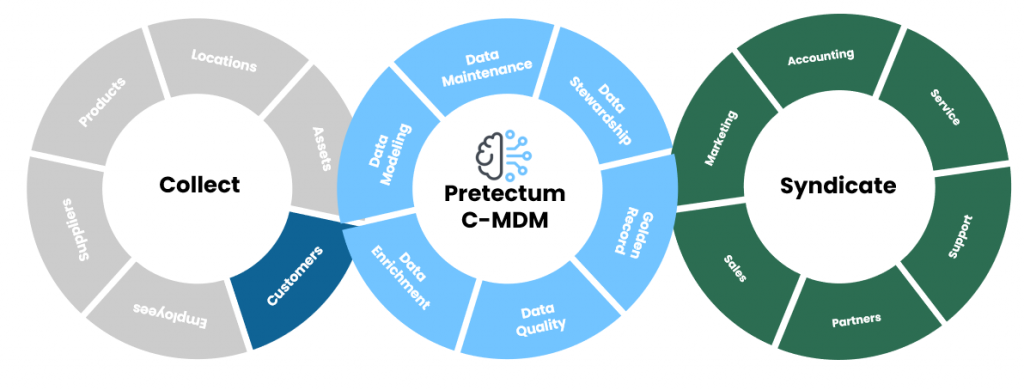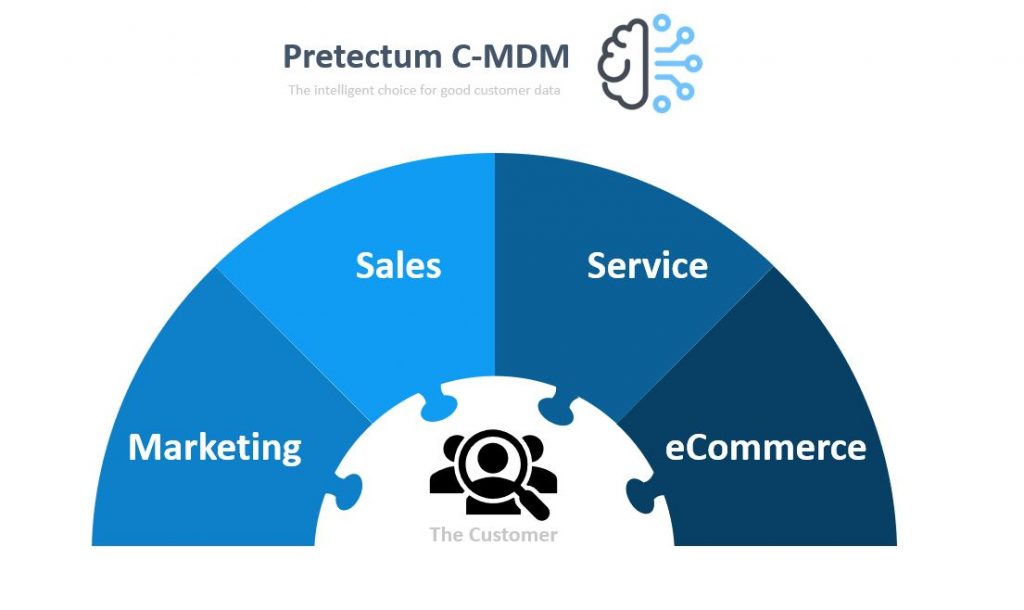You might have heard of the terms, Single customer view (SCV) or Golden Customer Record, 360 ° view of the customer, or the Customer Data 360. In themselves, they could potentially be referring to the same thing but you’ll find that vendors of software platforms all have slightly different views of what these terms mean and in the end, you have to decide what is necessary and most appropriate to the needs of your specific business. What is the problem that you’re looking to solve, with any Customer Master Data Management (CMDM) platform?
The Pretectum CMDM platform focuses principally on the Business-to-Consumer (B2C) space servicing industries such as health, property, telco, travel, financial services, retail, and insurance. For these types of customers, there are some very specific challenges that need to be addressed.

For these industries understanding the differences between customer records and recognizing that the same name and vital statistics could exist in ones’ systems for essentially different people even at the same address. These industry segments not only have a critical dependency on ensuring that they don’t have duplicates, but that the information that they do hold, is the best it possibly can be in order to meet regulatory compliance requirements, maximize service efficacy, optimize support and engage in suitable care and diligence when dealing with consumers.
Having a complete, correct, and appropriate repository that describes the customer is essential in the execution of cost-optimal activities and gives customers a superior level of confidence and comfort in their dealings with the business. Basic data, when augmented with enrichment datasets or data that is specifically pertinent to the relationship with the customer enables the business to provide a more personalized and intimate engagement relationship that supports better insights, more targeted messaging, and personalization.
Very few organizations successfully implement the concept of an SCV when they depend on their core data repositories that are focused principally on transaction processing. The reason for this is that the transactional system is often dealing with only a subset of data elements in contrast to all the data elements that the business has and potentially cares about.
As a consequence, customer service personnel in particular, only see a sliver of information that relates to customer service and support handling, and often this information is either outdated or inadequate relative to the needs of an optimal customer conversation. While privacy concerns or cost may hold a business back from creating tight integrations between their many platforms, the reality is that a Customer MDM (CMDM) can be of assistance in bridging the gap between silos of similar data records while still maintaining appropriate privacy and allowing due care and diligence among personnel to be applied in service of an ideal customer experience with the least amount of risk.
Great expectations
Customers expect there to be the potential for 24×7 support across multiple channels and touchpoints with consistency. That consistent experience is only possible with a centralized single source of truth that is being continuously maintained with the best possible descriptors of the customer. Customers also expect to be able to engage with businesses using the many channels of communication and engagement without having to repeatedly provide essential information that relates to them. They expect that journey to be tracked in the customer interaction platforms using the latest and current descriptions of them as customers.
The insurance industry has been struggling to move from risk-based product focus to customer focus. Also, with mergers and acquisitions and a proliferation of products, insurers have a difficult battle to win over customers selling products that are intangible with benefits that are realised in future years, if at all.
Customer MDMs are not meant to carry transactional logs of customer engagement, CIC, CRM, ERP, Service Desk, or Customer Data Platforms (CDP) are perhaps more appropriate for event entries. But, CMDM can carry key identifiers that describe the most recent interactions with a customer that can accelerate clarity on the engagement. A CMDM could, for example, track the ID of the last customer interaction ID, the last date of the interaction, and the last customer service person that they spoke to. This same system could also hold details of the last time the customer exchanged value with the business, the value of that exchange, and the medium or circumstances under which the exchange took place.

How a business chooses to create and maintain those linkages should be an aspect of flexibility that data owners should expect from their Customer Master Data Management platform.
A unified view of the customer is a starting point for sweeping digital transformation and holds the potential as a springboard for omni-channel customer experience initiatives. For that to happen, the adoption of a Customer MDM has to be recognized as a fundamental building block and it needs to be put in place.
The SCV or however you want to describe your centrally mastered customer data should provide a central store of the one version of the truth of the key information assets. It has the ability to bring structure and internal confidence to a critical repository of business data that in the long term represents a data asset for the organization. This same repository stands as a virtual representation of business reputation and the customer relationship.
These key attributes of a Customer Master become ever-increasingly important as businesses strive to differentiate themselves from their competitors and move ever closer to their customers in order to maintain loyalty and sustain an elevated customer lifetime value.


